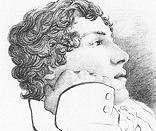John Keats, born in London in 1795, wrote the sonnet To Sleep when he was only twenty years old. In an iambic pentameter, the narrator talks directly to Sleep, asking "him" to provide escape from reality. With rimes in A-B-A-B structure, the author here makes a very melodic and harmonious poem. The author uses several figures of speech to address sleep in a very specific way. More over, it is possible that there was a relation between the context and Keat's personal life.
The author first starts by praising sleep, introducing it as a person who prepares us gently for midnight, symbolizing the night: "O soft embalmer of the still midnight" by closing our eyes and protecting us from the light:" shutting with careful fingers and benign our gloom pleas'd eye. Indeed, throughout the poem, we see that John Keats personifies sleep, when he gives "him" "careful fingers" but also with apostrophes such as "O soft embalmer", as if sleep could hear the calls of the narrator.
The personification is laso seen by the reader when the speaker asks sleep that if it pleases him, sleep may close his eyes, begging him to do so. which brings sleep to life even more" O soothest sleep! If so it pleases thee, close in the midst of this time hymn my willing eyes".
Moreover, the narrator also asks sleep to save him from his life's difficulties and troubles "then save me or the passed day will shine upon my pillow, breeding many woes". The speaker also introduces his conscience as an enemy which will see his bad qualities and bring back his worst memories. This personification is shown in the sentence "save me from curious conscience, that still lords its strength for darkness"/ John Keats makes several allusions to death. Indeed,


